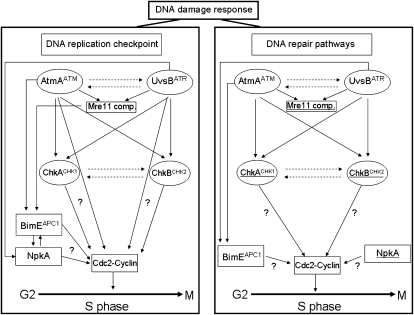Figure 9.—
The diagram is based on data from this article, Ye et al. (1996), Fagundes et al. (2004, 2005), and Malavazi et al. (2005). The DNA damage response was divided into DNA replication checkpoint (DRC, left) and DNA repair pathways (DRP, right). As in other eukaryotic cells, the DNA damage checkpoint in A. nidulans functions via phosphorylation of the NimXCdc2 Y15 (Ye et al. 1997). Ye et al. (1996) have shown the existence of two S-phase checkpoint regulatory systems that control initiation in mitosis. One, which involves Y15 phosphorylation of both NimXCdc2 and BimE, prevents initiation of mitosis when DNA replication is arrested and the other restrains mitosis via Y15 phosphorylation of NimXCdc2 when DNA replication is slowed. Our work showed that AtmA and UvsB as well as ChkA and ChkB played redundant roles during both DRC and DRP (dashed lines). Other interactions can also be observed during DRC. BimE interacts with AtmA and the Mre11 complex (Mre11 comp.) as well as with NpkA, a Cdc2-related kinase that plays a role in cell-cycle progression during S phase in A. nidulans (Fagundes et al. 2004). NimXCdc2 (AnkA) is interacting with AtmA in the DRC but not in the same pathway. The underlined genes had increased mRNA accumulation in the DRP (right). In the DRP, AtmA interacts with the Mre11 complex and BimE interacts with both AtmA and UvsB. NpkA and AnkACdc2 are interacting with AtmA in the DRP but not in the same pathway.

